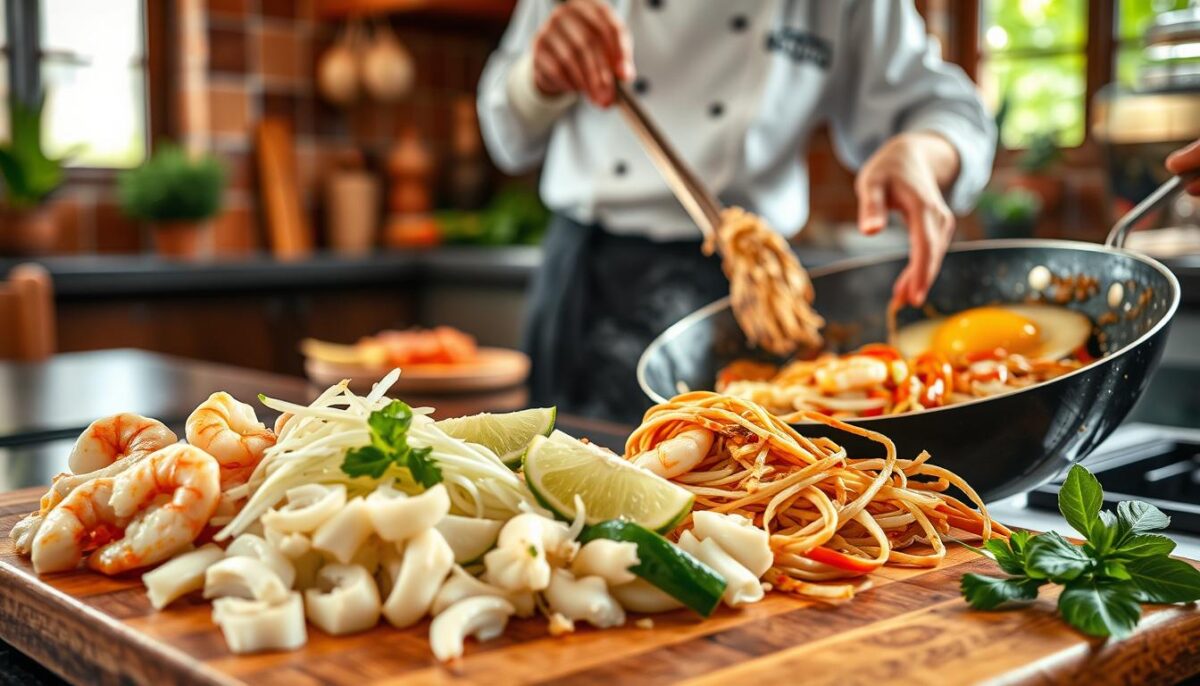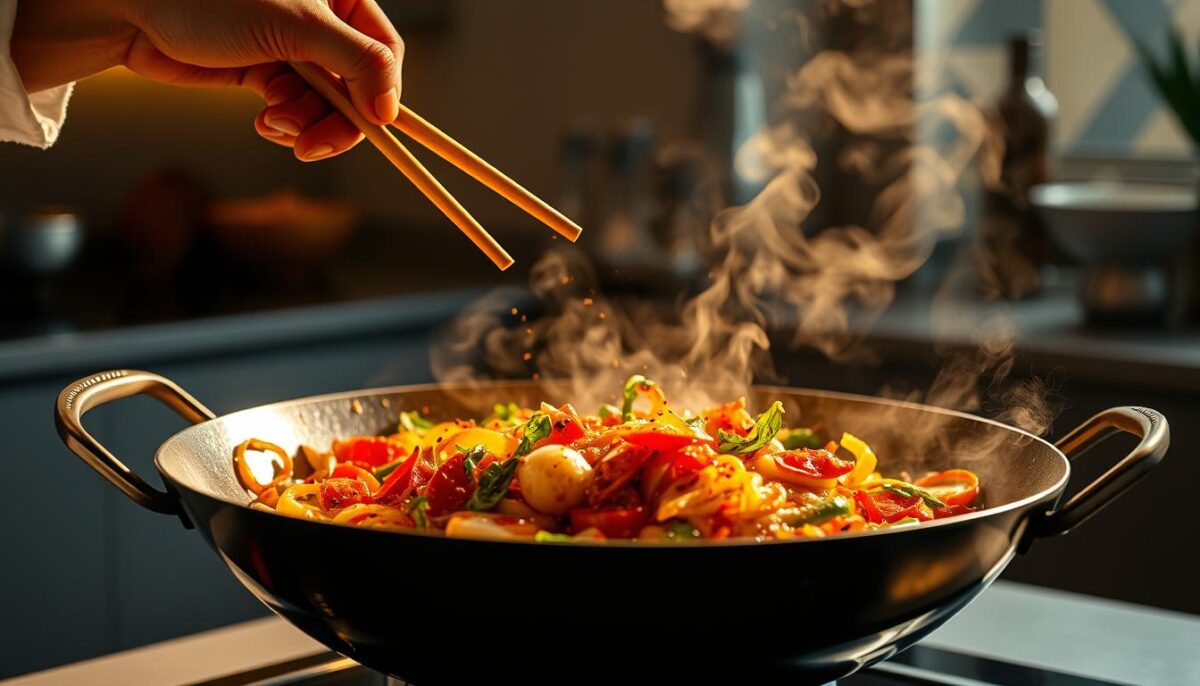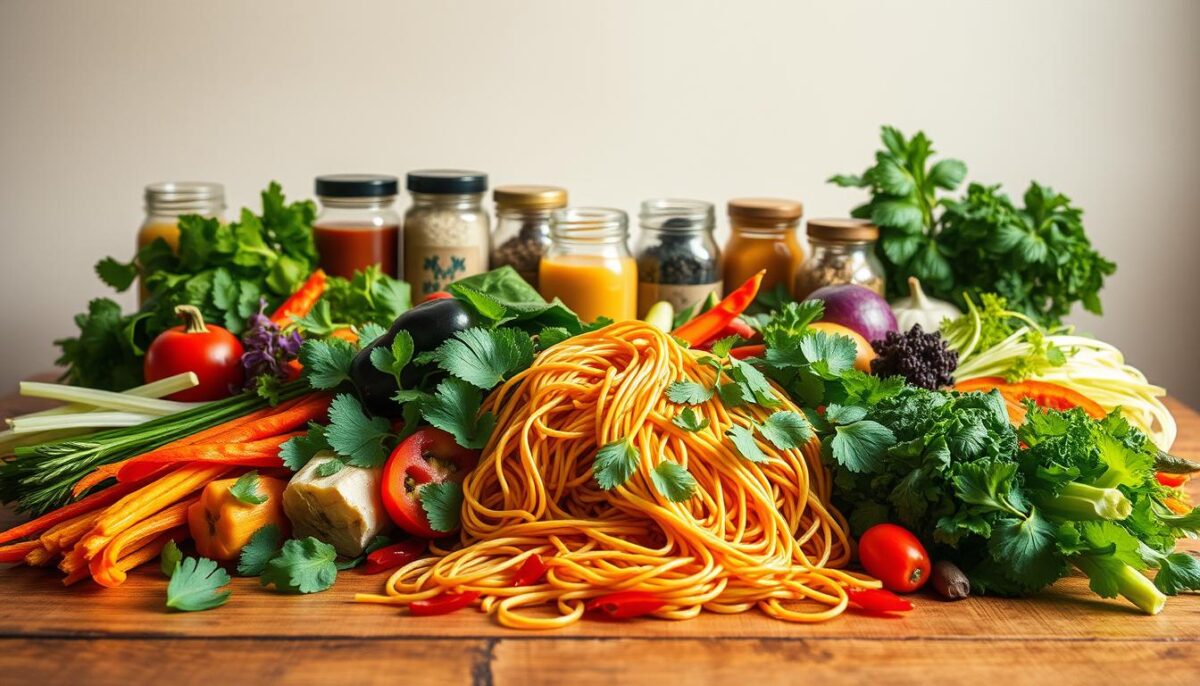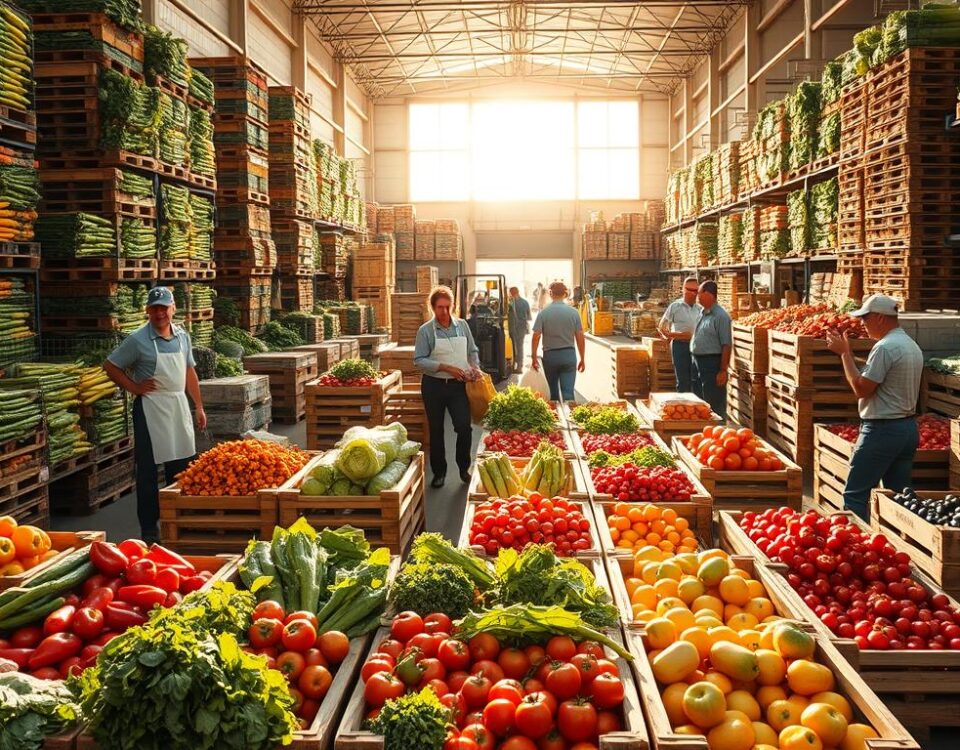
How to Perfect Slow-Cooked American BBQ Ribs at Home
May 4, 2025
Making the Perfect Spanish Paella Without a Trip to Valencia
May 4, 2025I’ll never forget the first time I tasted real Pad Thai. It wasn’t at a restaurant or during a trip abroad—it was in my tiny apartment kitchen, surrounded by grocery bags and a stubborn wok. After years of settling for takeout versions that tasted more like sugary noodles, I decided to reclaim this dish. What I discovered? Freshness isn’t just a buzzword—it’s the soul of authentic flavor.
My breakthrough came when I swapped pre-made sauces for a simple blend of tamarind, fish sauce, and palm sugar. Suddenly, the bright tang and subtle sweetness mirrored what I’d loved in street food stalls. I realized most Americanized recipes overcomplicate things—true magic happens when quality components shine.
This version keeps things straightforward without sacrificing depth. You’ll need rice noodles (the chewy backbone), your protein of choice, and that glorious sauce. The secret? A screaming-hot pan creates that signature smoky edge while keeping veggies crisp. It’s become my go-to for hectic evenings—proof that fast meals can still feel special.
Key Takeaways
- Fresh tamarind and fish sauce transform the flavor profile beyond typical takeout
- High heat cooking preserves texture and adds restaurant-quality char
- Customizable proteins make it adaptable for different diets
- Prep-friendly steps let you cook faster than delivery arrives
- Balancing sweet, sour, and salty elements is crucial for authenticity
Introduction to Authentic Thai Pad Thai
My culinary awakening began during a sweltering Brooklyn summer. While scrolling through food blogs, I stumbled on a chef’s Instagram story showing vibrant markets in Bangkok. The sizzle of woks and neon-pink rice noodles tossing in fiery pans sparked something primal. That night, I burned my first batch of shrimp trying to recreate the energy.
From Kitchen Disasters to Flavor Breakthroughs
Early attempts tasted like sweet cardboard until a Thai chef’s YouTube tutorial changed everything. “Real flavor comes from contrast,” she said, holding up a bottle of fish sauce. I learned to balance funky umami with tart tamarind – no more cloying sauces. Now, I keep prepped ingredients like bean sprouts and chopped peanuts set aside in mismatched bowls, just like street vendors do.
Why This Dish Feels Like Home
What makes me crave this recipe weekly? It’s the crunch of fresh veggies meeting caramelized edges on tofu. The way rice noodles soak up that golden sauce without turning mushy. Friends who’ve never touched fish sauce now beg for seconds. Best part? You can make pad thai faster than scrolling delivery apps – just keep everything set aside and ready to dance in the pan.
Step-by-Step Thai pad thai cooking Process
Many home cooks rush the soaking step, ending up with mushy noodles—I learned this the hard way. Perfect texture starts before the wok hits the flame. Trust me: patience here pays off in every chewy, saucy bite.

Preparation and Pre-Soaking the Noodles
For rice noodles that hold their shape, use warm (not boiling) water. Submerge them completely for 8-10 minutes until flexible but still firm. “They should bend without breaking,” as my favorite street vendor once told me. Drain thoroughly—soggy strands dilute the sauce.
Creating a Flavor-Balanced Sauce
Whisk together 3 tbsp tamarind paste, 2 tbsp palm sugar, and 1 tbsp brown sugar until smooth. The combo creates depth without overpowering sweetness. Add 2 tbsp fish sauce gradually, tasting as you go. Pro tip: lime wedges on the side let guests adjust tartness to their liking.
When everything’s measured and prepped, the actual stir-fry takes less than 5 minutes. I always make pad in two batches if feeding a crowd—overcrowding steams instead of sears. Follow these steps, and you’ll ditch takeout menus for good.
Sourcing Fresh Ingredients for Authentic Flavor
Selecting the best proteins and veggies transformed my results from “meh” to “more, please!” I learned that freshness isn’t just about expiration dates—it’s about how ingredients behave in the pan. Vibrant colors, crisp textures, and natural sweetness become your allies when you shop intentionally.
Choosing High-Quality Proteins and Veggies
For proteins, I alternate between plump wild shrimp and organic chicken thighs. When I add shrimp, I look for firm bodies with a mild ocean scent—mushy or ammonia-smelling ones ruin the dish. Chicken stays juicy when sourced from pasture-raised birds, sliced thin for quick cooking.
Scrambled eggs became my secret weapon after a Bangkok chef told me, “They’re not just protein—they’re silk for your sauce.” I whisk them until just combined, letting them set slightly before folding into noodles. For veggies, snap-tight bean sprouts and perky green onions add crunch without watering things down.
| Protein Type | Recommended Source | Cooking Tip |
|---|---|---|
| Shrimp | Wild-caught, fresh | Add last to avoid chewiness |
| Chicken | Organic, free-range | Slice thinly |
| Tofu | Non-GMO, firm | Press before cooking |
Crank your burner to medium-high heat—that sizzle when ingredients hit the pan is non-negotiable. It caramelizes sugars in the sauce while keeping veggies bright. And those green onions? Toss half during cooking, save the rest for garnish. The word “pad” itself means stir-fried, a nod to the technique’s cultural roots. Master these choices, and every bite becomes a tribute to tradition.
Perfecting the Pad Thai Sauce
The difference between forgettable and phenomenal lies in your sauce bowl. After testing 23 variations, I cracked the code for that addictive balance of sweet, tangy, and savory—no culinary degree required.
Building Flavor Foundations
Start with ¼ cup tamarind paste – its fruity acidity cuts through richness. Melt 3 tbsp palm sugar in a saucepan over low heat, then whisk in the tamarind. Add 2 tbsp fish sauce gradually: “Taste after each spoonful—it should make your tongue dance, not retreat,” advises a Bangkok street chef I follow.
The Taste Test Trick
Dip a rice noodle into the sauce. Perfect balance? Sweetness hits first, followed by sour punch, finishing with umami depth. Too sharp? Add a teaspoon of brown sugar. Flat? A squeeze of lime brightens it instantly.
Here’s my 3-minute workflow:
- Prep all sauce components before heating the pan
- Cook eggs separately for creamy ribbons, not rubbery bits
- Toss rice noodles just until coated – they’ll absorb flavors as they cool
Struggling with texture? Try soaking noodles 8 minutes instead of 10. They’ll firm up when hitting the hot sauce. For more exotic Asian dishes, balance is key—but here, trust your taste buds over strict measurements. That’s how street vendors roll.
Cooking Techniques and Tips for Stir-Frying
The sizzle of ingredients hitting the wok is where the magic happens. I once ruined three batches before realizing heat management separates home cooks from street food masters. Let’s break down the science behind that irresistible smoky flavor.

Maximizing Flavor with a Hot Wok
Preheat your pan until water droplets dance across the surface. This creates the Maillard reaction – that golden crust on proteins and veggies. For shrimp, wait until the oil shimmers before adding them. They’ll develop a slight char while staying juicy inside.
Balance is key with the sauce. Too much sugar burns quickly, while tamarind’s acidity needs high heat to mellow. I pour the mixture along the wok’s edges, letting it caramelize before tossing everything together.
Temperature Control and Timing
Stir-frying is a sprint, not a marathon. Cook in this order:
- Proteins first (90 seconds for shrimp)
- Veggies next (45 seconds)
- Sauce and noodles last (2 minutes max)
Crushed peanuts should always go in after removing from heat. Their oils turn bitter if cooked. Use this table as your cheat sheet:
| Ingredient | Ideal Temp | Max Time |
|---|---|---|
| Shrimp | Medium-high | 1.5 mins |
| Noodles | High | 2 mins |
| Sauce | Medium | 1 min |
Pro tip: Have everything measured and lined up like a sushi chef. Once that wok’s hot, there’s no time for rummaging through spice jars!
Variations and Adaptations for Dietary Preferences
What makes this dish a weeknight hero? Its chameleon-like ability to adapt. Whether you’re plant-based or protein-focused, a few smart swaps keep the spirit alive without compromising flavor.

Plant-Powered Twists That Deliver
For vegan versions, I skip eggs and use cubed tofu scrambled with turmeric for color. Replace fish sauce with a mix of soy sauce and mushroom powder – it keeps the umami punch. A friend taught me to add shredded carrots for sweetness, balancing the tang from fresh lime.
Protein Playground
Chicken thighs work better than breasts here – their fat content prevents dryness. When using shrimp, toss them in cornstarch first for a light crispness. My meatless go-to? Pressed tempeh marinated in lime juice and garlic. The acid tenderizes it beautifully.
| Protein | Best For | Cooking Tip |
|---|---|---|
| Chicken | High-protein diets | Slice against the grain |
| Tempeh | Vegan options | Steam before marinating |
| Shrimp | Quick meals | Cook 90 seconds max |
Don’t stress about using a traditional wok – a cast-iron skillet works if you crank the heat. Just avoid overcrowding. Garnish with extra bean sprouts and chili flakes for texture. Remember: Recipes are guidelines, not rules. Your taste buds make the final call!
Serving and Garnishing Ideas
The moment I realized garnishes weren’t just decoration? When a friend ate my noodles bare, then tried it with lime and peanut sprinkles. “It’s like two different dishes,” she said. Now I treat toppings as flavor amplifiers, not afterthoughts.

Start with a base of crushed roasted peanuts – their richness cuts through tangy sauces. I use a fork to press them gently into noodles, creating pockets of crunch. A Bangkok vendor once told me, “Garnishes should whisper, not shout.” That’s why I serve chili flakes separately, letting guests control the heat.
Traditional Toppings and Fresh Lime Wedges
Lime isn’t just for squeezing – rub a wedge around the bowl’s rim before plating. The citrus oils elevate every bite. For texture contrast, keep bean sprouts raw and add them last. Thinly sliced green onions make stripes of color that say “restaurant-quality” without effort.
Want depth? Swirl a teaspoon of tamarind paste on top before serving. It adds glossy sheen and an extra sour kick. My pro move: freeze lime juice into ice cubes for instant brightness. Toss one into leftovers when reheating – it revives the flavor like magic.
Presentation matters. Serve in shallow bowls to showcase layers. Let crimson chili flakes and emerald herbs create visual drama. Remember: we eat with our eyes first. A final dusting of peanut crumbs? That’s the edible confetti celebrating your kitchen win.
Storing, Reheating, and Make-Ahead Tips
Meal prep transformed my chaotic evenings into manageable feasts. By storing components smartly, I enjoy restaurant-quality meals in 10 minutes flat. The trick? Treat each element like a VIP guest needing its own backstage green room.
Efficient Meal Prep for Busy Weeknights
Cook noodles al dente and rinse with cold water to stop cooking. Store them dry in glass containers – they’ll absorb sauce better later. For protein, keep cooked shrimp or chicken separate from veggies. This prevents sogginess and lets you customize bowls.
Tofu lovers: Press and marinate cubes overnight. They develop deeper flavor while staying firm. Always store sprouts raw in breathable produce bags. A paper towel inside absorbs excess moisture that causes wilting.
| Component | Storage Method | Max Freshness |
|---|---|---|
| Noodles | Airtight container | 3 days |
| Sauce | Glass jar | 1 week |
| Sprouts | Paper towel + bag | 5 days |
Reheating works best in a skillet with 1 tsp water. Medium heat revives noodles without turning them gummy. Toss tofu or proteins in last – 30 seconds is enough to warm through. Garnish with fresh sprouts post-reheat for that essential crunch.
Pro tip: Freeze individual portions with sauce on the bottom. Microwave from frozen – the steam helps distribute heat evenly. Your future self will thank you during hectic days!
How I Personalized My Authentic Thai Pad Thai
Friends often ask what makes my version stand out—it’s all in the bold little adjustments. This dish became truly mine when I stopped treating recipes like commandments. A pinch more roasted garlic here, a bolder crack of pepper there—these tweaks turned familiar flavors into something unforgettable.
Favorite Tweaks and Flavor Boosts
Doubling the garlic changed the game. I sauté whole cloves until golden, then crush them into the sauce for a caramelized depth. For heat, I mix ground white pepper with chili flakes—the dual kick lingers without overwhelming. Presentation matters too: I always serve in my favorite handmade bowl, its wide rim showcasing vibrant garnishes.
Through trial and error, I found these ratios work best:
| Ingredient | Original | My Version |
|---|---|---|
| Garlic | 2 cloves | 4 cloves |
| Pepper | ½ tsp | 1 tsp + chili |
| Lime | 1 wedge | 2 wedges |
Don’t fear experimentation. Swap bowl sizes to control portion visuals, or add extra veggies for crunch. The dish adapts beautifully to personal tastes—trust your instincts. After all, the best meals reflect the cook’s personality as much as the culture they honor.
Conclusion
Mastering this iconic dish comes down to three essentials: your pan, your prep time, and those vibrant veggies. Through trial and error, I discovered that sizzling heat and fresh components create magic no takeout box can match. The journey from clumpy noodles to balanced perfection taught me that technique matters as much as ingredients.
Remember – a properly heated pan gives that smoky depth we all crave. Take time to prep components separately, and let crisp veggies add texture contrast. What starts as a weeknight experiment might just become your signature meal.
Thank you for joining me in this flavorful adventure! Now it’s your turn. Swap proteins, adjust spice levels, or play with herb garnishes. The beauty lies in making it yours. Just keep that golden ratio of sweet, salty, and tangy – and always, always finish with fresh lime wedges.
Grab your favorite skillet, set aside 30 minutes, and let those market-fresh veggies shine. You’ve got this. And when you taste that first forkful? You’ll know why every second was worth it.
FAQ
Can I substitute fish sauce if I don’t have it?
I’ve found soy sauce or coconut aminos work in a pinch, but they’ll change the flavor. Authentic fish sauce adds that signature umami depth, so I recommend tracking it down at Asian markets or online.
How long should I soak rice noodles before cooking?
I soak them in room-temperature water for 30-45 minutes until flexible but still slightly firm. Over-soaking makes them mushy when stir-fried. Test a strand – it should bend without snapping.
What’s the best protein to use besides shrimp?
I love crispy tofu or thinly sliced chicken thighs. For vegetarian versions, double up on scrambled eggs or add extra peanuts for crunch. The sauce’s sweet-sour balance works with almost any protein!
Can I make this vegan-friendly?
Absolutely! Swap fish sauce for fermented soybean paste or vegan “fish” sauce, use tofu, and skip eggs. I’ve even used mashed chickpeas as an egg substitute – just adjust tamarind and palm sugar to taste.
Why does my stir-fry turn soggy?
Heat is key! I crank my wok to medium-high before adding oil. Cook proteins first, then push them aside. Noodles need quick, high-heat tossing – overcrowding the pan steams them instead of searing.
How do I fix sauce that’s too sweet or salty?
Balance is everything. Too sweet? Add lime juice or vinegar. Too salty? A pinch of brown sugar helps. I always taste my sauce mix before cooking and adjust with tiny increments.
Can I prep ingredients ahead of time?
Yes! I pre-chop garlic, green onions, and proteins, storing them separately. Sauce keeps refrigerated for 3 days. Soak noodles 1-2 hours before cooking – they’ll hold well in a sealed container with a splash of water.
What’s a good tamarind paste alternative?
In emergencies, I mix lime juice with a bit of brown sugar or mango puree. It won’t replicate tamarind’s tangy complexity, but adds brightness. Look for tamarind concentrate at international grocery stores for best results.
How do I get that smoky “wok hei” flavor at home?
I achieve this by letting my pan get screaming hot before adding oil. Quick tossing creates slight charring on noodles and proteins. A gas stove works best, but even electric burners can deliver with proper heat management.
Can I freeze leftovers?
I don’t recommend freezing – noodles turn grainy. Store leftovers refrigerated for up to 3 days. Reheat in a hot pan with a splash of water to revive texture. Garnish with fresh lime and sprouts before serving again.



